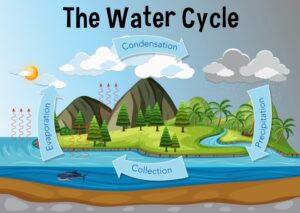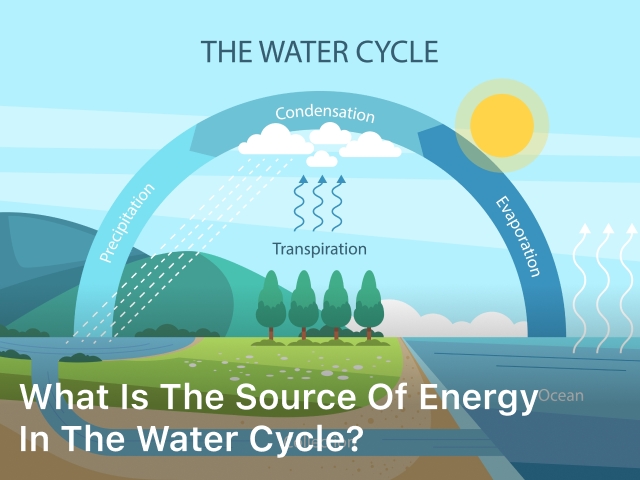What is The Sun’s Role in The Water Cycle?

naturepreservehub.com. What is the Sun’s Role in The Water Cycle? – Discover the crucial role the sun plays in the water cycle. Explore the science behind this natural process, its impact on our planet, and more.
The water cycle, also known as the hydrologic cycle, is a fundamental process that sustains life on Earth. It’s a continuous journey that water molecules embark on, circulating between the atmosphere, land, and oceans.
One key player in this complex natural dance is the sun. In this comprehensive article, we will delve into the various facets of the sun’s role in the water cycle, shedding light on its significance and the science behind it.
The Sun’s Crucial Role
Solar Energy Ignites the Cycle
At the heart of the water cycle is the sun’s radiant energy. This energy serves as the driving force that kickstarts the cycle. When sunlight reaches the Earth’s surface, it warms the land and water bodies. This heat energy, in turn, leads to the evaporation of water.
Evaporation: The First Step
Evaporation is a crucial phase in the water cycle. It occurs when the sun’s energy causes water from rivers, lakes, and oceans to transform into water vapor. This invisible vapor rises into the atmosphere, forming clouds over time.
Condensation: Cloud Formation
As water vapor ascends into the atmosphere, it cools down and condenses into tiny water droplets. These droplets come together to form clouds. Clouds are the visible evidence of this condensation process, and they play a significant role in the distribution of water on Earth.
Precipitation: Release of Water
Clouds, as they accumulate more water droplets, eventually reach a point where they can no longer hold the moisture. This leads to precipitation, which includes rain, snow, sleet, or hail, depending on temperature and atmospheric conditions. Precipitation is the Earth’s way of replenishing its water resources.

Sun’s Influence on Climate
The sun’s role in the water cycle extends beyond the immediate processes. It also plays a vital role in shaping the Earth’s climate. Here’s how:
Solar Radiation and Climate Patterns
The varying intensity of solar radiation throughout the year, caused by the Earth’s axial tilt, influences climate patterns. Regions that receive more direct sunlight experience warmer temperatures, while those at an angle receive less heat, resulting in cooler climates. These temperature differences drive wind and ocean currents, affecting weather patterns and precipitation distribution.
El Niño and La Niña
The sun’s energy is a key driver of the El Niño and La Niña phenomena. These climate patterns occur due to changes in sea surface temperatures in the Pacific Ocean, which are influenced by solar energy distribution. El Niño can lead to excessive rainfall and flooding in some regions, while La Niña is associated with drier conditions and even droughts.
Sun’s Role in Sustainable Ecosystems
Support for Plant Growth
The sun’s energy is essential for photosynthesis, the process by which plants convert sunlight into energy and produce oxygen. This process not only sustains plant life but also ensures the availability of oxygen in our atmosphere, which is vital for all living organisms.
Maintaining Aquatic Ecosystems
The water cycle, driven by the sun, maintains aquatic ecosystems. It replenishes freshwater sources, ensuring the survival of countless aquatic species and supporting the fishing industry, a crucial source of food for many communities.
What is the role of the sun in the water cycle quizlet?
The Sun plays a crucial role in the water cycle. Here’s a brief explanation of its role in the water cycle:
- Evaporation: The Sun’s heat causes water from various sources, such as lakes, rivers, and oceans, to evaporate into water vapor in the atmosphere. This process is essential for the water cycle to begin.
- Transpiration: The Sun also drives transpiration, where plants release water vapor from their leaves into the atmosphere. This process contributes to the moisture in the air.
- Condensation: As the water vapor rises into the atmosphere, it cools and condenses to form tiny water droplets or ice crystals, creating clouds. The Sun’s energy helps drive this condensation process.
- Precipitation: When the water droplets in clouds become heavy enough, they fall to the Earth’s surface as precipitation, such as rain, snow, sleet, or hail. The Sun’s energy is indirectly responsible for lifting moisture-laden air into the atmosphere, where it can cool and condense to form precipitation.
- Runoff: Precipitation that falls onto the Earth’s surface can flow into rivers, lakes, and oceans. The Sun’s energy helps drive the process of evaporation from these bodies of water, returning water vapor to the atmosphere and completing the water cycle.
In summary, the Sun’s energy is the driving force behind the water cycle, as it provides the heat necessary for evaporation, transpiration, and the subsequent condensation and precipitation that replenish Earth’s water sources.
FAQs
How does the sun’s energy cause evaporation?
The sun’s energy, in the form of heat, causes water molecules to gain enough kinetic energy to escape from the liquid state and turn into water vapor. This process is known as evaporation.
Can the sun’s activity impact the water cycle?
Yes, fluctuations in the sun’s energy output, such as solar flares or sunspots, can affect the Earth’s climate and, consequently, the water cycle. However, these effects are relatively minor compared to other factors like greenhouse gas emissions.
Is the water cycle a closed system?
Yes, the water cycle is a closed system. Water molecules continuously cycle between the Earth’s surface, the atmosphere, and back again. Very little water is lost to space.
How long does it take for water to complete the water cycle?
The time it takes for a water molecule to complete the water cycle can vary. Some water molecules may evaporate and precipitate relatively quickly, while others may take hundreds or even thousands of years to complete the cycle.
Can human activities impact the water cycle?
Yes, human activities such as deforestation, urbanization, and pollution can disrupt the natural water cycle. For example, deforestation can reduce transpiration, affecting local rainfall patterns.
How can we conserve and protect the water cycle?
Conserving and protecting the water cycle involves sustainable management of water resources, reducing pollution, and minimizing our carbon footprint. Individual actions, such as using water efficiently and reducing waste, also play a role.
Conclusion
The sun’s role in the water cycle is nothing short of remarkable. From initiating the cycle through evaporation to shaping climate patterns and supporting ecosystems, the sun is an indispensable player in this intricate dance of water and life on Earth.
Understanding the sun’s influence on the water cycle not only deepens our appreciation for the natural world but also underscores the importance of responsible stewardship to preserve this vital process for future generations.





